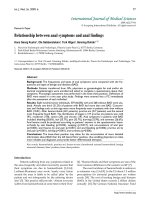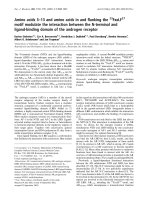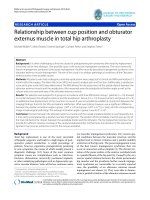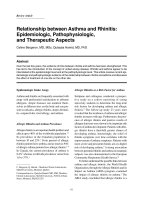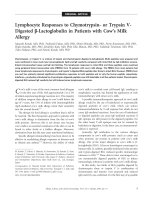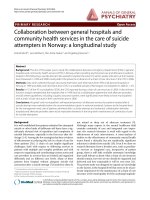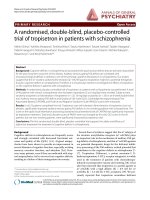Báo cáo y học: "Relationship between Anti-CCP Antibodies and Oxidant and Anti-Oxidant Activity in Patients with Rheumatoid Arthrit"
Bạn đang xem bản rút gọn của tài liệu. Xem và tải ngay bản đầy đủ của tài liệu tại đây (371.71 KB, 9 trang )
Int. J. Med. Sci. 2011, 8
139
I
I
n
n
t
t
e
e
r
r
n
n
a
a
t
t
i
i
o
o
n
n
a
a
l
l
J
J
o
o
u
u
r
r
n
n
a
a
l
l
o
o
f
f
M
M
e
e
d
d
i
i
c
c
a
a
l
l
S
S
c
c
i
i
e
e
n
n
c
c
e
e
s
s
2011; 8(2):139-147
© Ivyspring International Publisher. All rights reserved.
Research Paper
Relationship between Anti-CCP Antibodies and Oxidant and Anti-Oxidant
Activity in Patients with Rheumatoid Arthritis
Levent Ediz
1
, Ozcan Hiz
1
, Halil Ozkol
2
, Elif Gulcu
1
, Murat Toprak
1
, Mehmet Fethi Ceylan
3
1. Yuzuncu Yil University, Medical Faculty, Department of Physical Medicine Rehabilitation and Rheumatology, Van,
Turkey;
2. Yuzuncu Yil University, Medical Faculty, Department of Medical Biology, Van, Turkey;
3. Yuzuncu Yil University, Medical Faculty, Department of Orthopaedics, Van, Turkey
Corresponding author: Associate Professor Levent Ediz, MD, PhD. Yuzuncu Yil University, Medical Faculty, Department
of Physical Medicine and Rehabilitation, 65100 Van, Turkey. Tel.:+90 432 2150182; fax:+90 432 2168352. E-mail address: le-
Received: 2010.12.09; Accepted: 2011.02.01; Published: 2011.02.09
Abstract
Objective/Aim: A new group of autoantibodies in Rheumatoid Arthritis (RA), the anti-cyclic
citrullinated peptide (anti-CCP) antibodies directed to citrulline-containing proteins, which
are of value for the severity of RA. Up to date, the relationship between anti-CCP antibodies
and oxidant, anti-oxidant activity in patients with RA has not been elucidated in the previous
studies. In this study we aimed to investigate the effect of anti-CCP antibodies in the circu-
lation on whole blood, serum and synovial fluid oxidant and anti-oxidant activity in patients
with RA. Materials and Methods: RA patients with anti-CCP (+) (n=25) and anti-CCP (-)
(n=24) were recruited into the study. All patients had a positive rheumatoid factor (RF). The
patients who were under treatment with only non-steroidal antiinflammatory drugs (NSAID)
at the study time included in the study. Catalase (CAT), Glutathione peroxidase (GSHPx),
Myeloperoxidase (MPO) activities and the levels of Malondialdehyde (MDA) were measured
in whole blood, serum and synovial fluid in both groups. Results: There were no significant
differences in terms of the mean whole blood and serum antioxidative activity (CAT, GSHpx)
and the mean blood and serum MDA and MPO values (oxidative activity), between the pa-
tients with anti-CCP(+) and those with anti-CCP(-). There was increased synovial oxidant
activity (MDA and MPO levels) (p<0.05) in anti-CCP(+) RA patients with or without ESR
negativity when compared with anti-CCP(-) RA patients. There was positive correlation
between anti-CCP antibody levels and synovial MDA and MPO levels (r=0.435, p<0.05,
r=0.563, p<0.05 respectively) in anti-CCP (+) group. Conclusions: In conclusion, anti-CCP
antibody positivity seems to be associated with increased synovial fluid oxidant activity (in-
creased MDA and MPO levels) in patients with RA. These conclusions need to be validated in
a larger controlled study population.
Key words: Oxidative stress; Rheumatoid arthritis; Anti-CCP antibody; Malondialdehyde;
Myeloperoxidase; Synovial fluid
Introduction
Rheumatoid Arthritis (RA) is a chronic, inflam-
matory, autoimmune, systemic disease, in which
various joints in the body are inflamed, leading to
swelling, pain, stiffness, and the possible loss of func-
tion. Pathologically, synovial proliferation and de-
struction of the articular cartilage and bone occur in
the disease course [1]. Free radical/reactive oxygen
species (ROS) can be defined as a chemical species, an
Int. J. Med. Sci. 2011, 8
140
atom or a molecule that has one or more unpaired
electrons in its valance shell which makes it unstable,
short lived and highly reactive, therefore, for gaining
stability, it attacks the nearest stable molecule “steal-
ing” its electron. When the attacked molecule looses
its electron, it becomes a free radical itself, beginning a
chain reaction cascade resulting in disruption of a
living cell [2]. It is well established now that free rad-
icals/ROS play an important role in chronic inflam-
mation [2]. Oxygen metabolism has an important role
in the pathogenesis of RA. Free radicals/ROS pro-
duced in the course of cellular oxidative phosphory-
lation and repetitive cycles of hypoxia and reoxygen-
ation, along with oxidants produced by phagocytic
cells such as macrophages and neutrophils, lead to
chronic oxidative stress in the RA synovial microen-
vironment and the other tissues [3].
Increased oxidative stress in synovial tissue and
synovial fluid may be associated with increased dis-
ease activity, tissue demage and bone erosions in RA.
It has been shown that, especially in RA, monocytes
produce 2.7 times more oxygen radicals than controls
[4]. Clinical evidence has also suggested oxidative
stress is elevated in RA patients. Plasma malondial-
dehyde (MDA), a degradation product of lipid pe-
roxidation, level was significantly higher in the syno-
vial fluid and serum of RA patients than that of con-
trol subjects [5,6]. Epidemiologic studies have also
shown an inverse association between dietary intake
of antioxidants and RA incidence [7], and inverse as-
sociations between antioxidant levels and inflamma-
tion have been found [8,9].
A new group of autoantibodies that have gener-
ated particular interest are the anti-cyclic citrullinated
peptide (anti-CCP) antibodies directed to citrul-
line-containing proteins, which appear to be of value
for the diagnosis and especially severity of RA [10],
and also closely correlated to inflammatory disease
activity (Disease Activity Score-DAS28) scores and the
presence, development, and extent of joint erosions
[1]. Anti-CCP antibodies are actively produced or
enriched at the site of inflammation (joints and syno-
vial tissue) and may play an active role in the patho-
genesis of Anti-CCP positive RA by enhancing oxida-
tive stress in rheumatoid joint [11]. Indeed, high titers
of anti-CCP antibodies have been associated with an
erosive disease course and outcome in RA [1,10,12].
Anti-CCP antibodies can also induce or enhance ar-
thritis and tisuue demage in the mouse [13].
The effects of anti-CCP antibodies on whole
blood, serum and synovial fluid oxidant and an-
ti-oxidant activity in patients with RA has not been
elucidated in the previous studies. In this study we
aimed to investigate the effect of anti-CCP antibodies
in the circulation on whole blood, serum and synovial
fluid oxidant and anti-oxidant capacity in patients
with RA.
Methods
RA patients with anti-CCP (+) (n=25) and an-
ti-CCP (-) (n=24) were recruited into the study. All
patients fulfilled the revised American College of
Rheumatology (ACR) criteria for RA [14]. All patients
had a positive rheumatoid factor (RF). RF negative
patients were excluded from the study. Consent for all
procedures was obtained from each individual and
from the university research ethics committee. Blood
and synovial fluid samples were taken from the pa-
tients. The patients were chosen for the study after
having a preliminary evaluation consisting of a brief
medical history, smoking and alcohol habits and
physical examinations. Inflammatory disease activity
was defined as a Disease Activity Score (DAS 28). All
patients evaluated in terms of RF, CRP, ESR, and an-
ti-CCP2 status. DAS 28 scores, tender joint count, du-
ration of morning stiffness. Patients with any history
of chronic diseases such as liver diseases, diabetes
mellitus, respiratory disorders, cardiovascular dis-
eases and alchohol usage and smoking were not in-
cluded in the study. The patients who were under
treatment with only NSAID at the study time in-
cluded in the study. Those who had been receiving
corticosteroid agents and under treatment with dis-
ease modifying anti-rheumatic drugs and anti-TNF or
other biological agents for at least 3 months before the
study date were excluded from this study.
Determination of anti-CCP2 antibody
Anti–CCP2 antibody was determined by ELISA
(Immunoscan RA Mark 2; Euro-Diagnostica, Arnhem,
The Netherlands) which was performed according to
the manufacturer’s instructions (sensitivity 74%,
specificity 97–99%).
Determination of oxidant and antioxidant activi-
ties in whole blood, serum and synovial fluid
Totally 5 ml sample of venous blood and 3 ml
sample of synovial fluid from knee was taken from
each individual in the morning, before breakfast. 2 ml
of them was taken in tube with EDTA, and the rest in
biochemical tube. Samples were kept in a cool box at
+4 °C until they were transferred immediately to the
laboratory, where they were immediately centrifuged.
Serum was stored at -20 °C until analysis. The serum
samples were obtained by centrifuging blood samples
at 3000 rpm for 15 min at +4 °C. Whole blood samples
and synovial fluid were hemolyzed with distillated
water then they were centrifuged at 4000 rpm for 10
Int. J. Med. Sci. 2011, 8
141
min at +4 °C. The clear upper supernatant fluid was
taken. Catalase (CAT), Glutathione peroxidase
(GSHPx), Myeloperoxidase (MPO) activities and the
levels of Malondialdehyde (MDA) were measured in
whole blood, serum and synovial fluid.
Malondialdehyde (MDA) analysis
Lipid peroxidation (MDA) levels of whole blood,
serum and synovial fluid were measured with the
thiobarbituric acid reaction by the method of Placer et
al. [15]. The quantification of thiobarbituric acid reac-
tive substances was determined by comparing the
absorption to the standard curve of MDA equivalents
generated by acid catalyzed hydrolysis of 1,1,3,3 tet-
ramethoxypropane. The optical density was meas-
ured at 532 nm for samples MDA level (Shimadzu
UV-VIS Spectrophotometer UV1201). The level of
MDA was expressed as nmol/ml sample.
Catalase (CAT) analysis
CAT (EC 1.11.1.6) activity was determined by
the method of Aebi [16]. The principle of the assay is
based on the determination of the rate constant (s
−1
, k)
of the H
2
O
2
decomposition rate at 240 nm. Activities
were expressed as k ml
−1
sample.
Glutathione peroxidase (GSH-Px) analysis
GSH-Px activity of the whole blood, serum and
synovial fluid samples was measured spectrophoto-
metrically (Shimadzu 2R/UV–Vis) at 378C and 412
nm according to Matkovics et al [17]. GSH-Px activity
in samples was expressed as units (U/ml) of GSH-Px
activity.
Myeloperoxidase (MPO) analysis
MPO activity was measured according to the
modified method of Bradley et al [18]. MPO activity in
the supernatant was determined by adding 100 µl of
the supernatant to 1.9 ml of 10 mmol/l phosphate
buffer (pH 6.0) and 1ml of 1.5 mmol/l o-dianisidine
hydrochloride containing 0.0005% (w/v) hydrogen
peroxide. The changes in absorbance at 450 nm of
each sample were recorded on a UV-Vis spectropho-
tometer. MPO activity in samples was expressed as
units (U/ml) of MPO activity.
Statistical analysis
Results were expressed as mean and standard
deviation (SD). Statistical analysis was carried out
using the SPSS program (version 13.0 software, SPSS
Inc. Chicago, Illinois, USA). For the comparison of
groups, independent student t test and
Mann-Whitney U test were used. P values of less than
0.05 were regarded as significant. Spearman rank
correlation analysis was applied to assess correlation.
Results
The RA subjects with anti-CCP (+) were 25 indi-
viduals (18 females, 7 males), aged 39 to 63 years
(mean age 54.4 ± 9.6). The mean anti-CCP antibody
levels was 96.72± 61.07 U/ml (mean±SD) in an-
ti-CCP(+) group. The RA patients without anti-CCP
consisted of 24 individuals (19 females, 5 males), aged
42 to 62 years (mean age 56.2 ± 11.2). As shown in
Table 1, RA patients with anti-CCP(+) had signifi-
cantly higher DAS 28 scores, tender joint count and
morning stiffness time (p<0.01) than that of those with
anti-CCP(-). Other demographic, clinical and labora-
tory characteristics did not show statistically signifi-
cant differences between groups.
There were no significant differences in terms of
the mean whole blood and serum antioxidative activ-
ity (CAT, GSHpx) and the mean blood and serum
MDA and MPO values (oxidative activity), between
the patients with anti-CCP(+) and those with an-
ti-CCP(-) (Table 2).
In the synovial fluid, there was increased syno-
vial oxidant activity (MPO and MDA levels) (p<0.05)
in anti-CCP(+) patients with RA when compared with
anti-CCP(-) RA patients (Table 3). There were no sig-
nificant differences in terms of the mean synovial an-
tioxidative activity (CAT, GSHpx) values between the
patients with anti-CCP(+) and those with anti-CCP(-).
Spearman’s correlation showed positive correla-
tions between serum anti-CCP antibody levels and
synovial MDA and MPO levels (r=0.435, p<0.05,
r=0.563, p<0.05 respectively) in anti-CCP (+) group
(Figure 1). But there were no significant correlations
between anti-CCP antibody levels and whole blood
and serum MPO, MDA, GSHpx and CAT levels as
well as synovial GSHpx and CAT levels in anti-CCP
(+) group.
Because of oxygen metabolism (Free radi-
cal/reactive oxygen species) is related with inflam-
mation, to reveal the relationship between anti-CCP
and synovial fluid oxygen metabolism we examined
oxidative status in ESR negative patients. Although,
there is no clear rational cut off for activity (or for
normality) of ESR in RA, the usual clinical trial activ-
ity cutpoints for ESR are 28–30 mm/h [19]. For that
reason, a cut off value for ESR negativity was assessed
as 28 mm/h. Ten patients in anti-CCP(+) group and
12 patients in anti-CCP(-) group were ESR negative.
While only ESR negative patients compared between
the groups, there were no significant differences in
terms of serum oxidant levels and antioxidant activity
(p>0.05). On the other hand, there were still signifi-
cant differences between the groups in terms of syn-
Int. J. Med. Sci. 2011, 8
142
ovial oxidant levels (MDA and MPO levels) (p<0.05)
(Table 4). Moreover, there was still a significant posi-
tive correlation between serum anti-CCP and synovial
fluid MPO levels [r=0.693, p<0.05- but not synovial
fluid MDA levels (r=0.480, p>0.05)] in ESR negative
patients of anti CCP(+) group (Figure 2).
Table 1 Demographic and some clinical and laboratory characteristics of RA patients with anti-CCP (+) and anti-CCP (-).
Feature Anti-CCP(+) (n=25)
(mean ±SD)
Anti-CCP(-) (n=24)
(mean ±SD)
P value
Age (years) 54.4 ± 9.6 56.2 ± 11.2 NS
Gender female/male 18/7 19/5 NS
Body mass index (BMI) kg/m
2
24.5±1.4 25.3±1.9 NS
Duration of disease (years) 9.6 ± 6.3 8.1 ± 7.5 NS
Morning stiffness (minutes) 34.7 ± 33.6 17.8 ± 23.5 0.004*
Tender joint count 5.7 ± 5.2 2.8± 3.3 0.007*
DAS 28 scores 4.1± 1.8 3.4± 1.3 0.006*
ESR mm/hr 37.9 ± 26.8 33.6 ± 21.3 NS
CRP mg/L 34.3 ± 23.8 31.4 ± 29.8 NS
*p<0.01, NS: Nonsignificant
Table 2 Serum and whole blood oxidant activity; MDA and MPO levels, and antioxidant activity; CAT and GSH-Px levels in
anti-CCP(+) and anti-CCP(-) patients with RA.
Anti-CCP N Mean Std. Deviation p value
Serum GSHpx (U/ml) negative 24 0.47 0.25 0.622
positive 25 0.48 0.19
Whole Blood GSHpx (U/ml) negative 24 14.10 6.67 0.614
positive 25 15.63 4.39
Serum CAT
(k ml
−1
)
negative 24 0.11 0.03 0.267
positive 25 0.13 0.01
Whole Blood CAT (k ml
−1
) negative 24 114.23 21.15 0.322
positive 25 112.21 20.66
Serum MDA (nmol/ml) negative 24 3.34 0.15 0.141
positive 25 3.52 0.32
Whole Blood MDA (nmol/ml) negative 24 50.39 7.29 0.233
positive 25 53.63 7.50
Serum MPO (U/ml) negative 24 0.64 0,28 0.487
positive 25 0.62 0,20
Whole Blood MPO (U/ml) negative 24 67.44 25.04 0.218
positive 25 71.13 20.93
Table 3 Synovial fluid oxidant activity; MDA and MPO levels, and antioxidant activity; CAT and GSH-Px levels in an-
ti-CCP(+) and anti-CCP(-) patients with RA.
Anti-CCP antibody N Mean Std. Deviation p value
Synovial GSHpx (U/ml) negative 24 0.072 0.027 0.432
positive 25 0.074 0.032
Synovial CAT (k ml
−1
) negative 24 0.156 0.088 0.324
positive 25 0.145 0.086
Synovial MDA
(nmol/ml)
negative 24 2.852 0.509 0.021*
positive 25 4.592 0.780
Synovial MPO (U/ml) negative 24 3.134 2.125 0.037*
positive 25 4.783 2.654
*p<0.05
Int. J. Med. Sci. 2011, 8
143
Table 4. Synovial fluid MDA and MPO levels of the subjects whom ESR was below 28 mm/h in anti-CCP(+) and anti-CCP(-)
groups.
Anti-CCP antibody N Mean Std. Deviation p value
Synovial MDA
(nmol/ml)
negative 12 2.912 0.712 0.048*
positive 10 4.314 0.780
Synovial MPO (U/ml) negative 12 3.303 1.865 0.032*
positive 10 4.895 2.476
*p<0.05
Fig 1. There were significant correlations between the antibodies against citrullinated peptide (CCP-AB) levels and synovial
MDA and MPO levels (r=0.435, p<0.05, r=0.563, p<0.05 respectively) in the anti-CCP(+) RA population.


